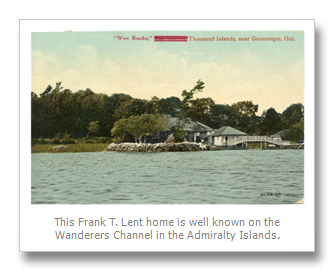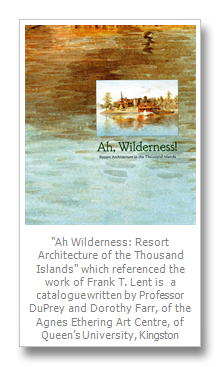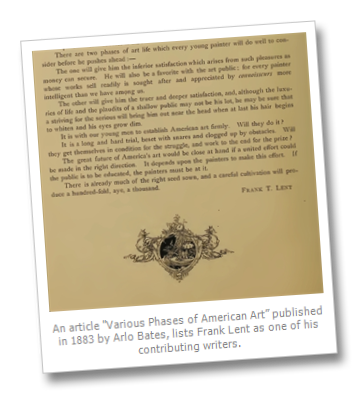I live a long way from the Thousand Islands but my quest to discover who designed my home in Worcester, Massachusetts led me on the most delightful journey. It all began when I found eight pages of blueprints tucked inside of an old window seat. and, thanks to “Google” I discovered Frank T. Lent (1855-1919).
Further searched let me to my most encouraging booster, Dr. Pierre de la Ruffinière du Prey, recently retired Professor and Research Chair in the Department of Art History at Queen’s University in Kingston ON. He gave me important advice, “Hang on to those Lent drawings, you are fortunate to have them.” Thus began my journey.
My first quest led me to research the owners of my home on Morningside Road in Worcester. George Bieberbach, my home’s first resident, He came to Worcester in 1867 and by 1882 was engaged in the wholesale brewer business. In fact, Mr. Bieberbach brewed the first lager beer in New England.
However, the link to the Thousand Islands became clear when I found Frank T. Lent’s obituary (Gananoque Reporter Dec. 15, 1919). It noted that he married Fannie Dean in 1902 and that they had one son, Deane, born in 1907. Also mentioned was that the “late Mr. Lent made his home in Gananoque some years ago, during which time he designed and superintended some of the most pretentious buildings in town and on various islands, and after his removal to Sterling [MA], always returned to Gananoque to spend his summers, occupying his cottage "Wee Rocks" on the south side of McDonald Island. He is survived by his wife and one teen age son, just entering his teens"
That link sent me to Thousand Islands Life Magazine. I sent an inquiry asking if there were any pictures, or information, on “Wee Island”. Editor, Susan Smith kindly directed me to Catherine Van Sickle, who lives in Lent’s summer home on Wee Island (Now called “La Vignette” and part of the Admiralty Group, near Gananoque). On EBay I found a postcard, of “Wee Rocks”, which I bought and sent Susan.


Professor du Prey had written a book called Ah Wilderness: Resort Architecture of the Thousand Islands which referenced the work of Frank T. Lent [1855-1919] The book is actually a catalogue written by Professor du Prey and Dorothy Farr, of the Agnes Etherington Art Centre, of Queen’s University for an exhibit mounted first at Queen’s University in 2004. The catalogue contained two references to Lent’s work - Nakomis Lodge on Howe Island and the Atkinson cottage on Big White Calf (part of the Admiralty Group). Two of Professor du Prey’s graduated students, Summer Harris and David McKay wrote the architectural reviews and provided links for my research.
More information came from an article posted on the website of the Sleepy Hollow Bed and Breakfast in Gananoque, Ontario, which was built in 1905. It was constructed for the prominent Gananoque manufacturer, and provincial politician, Frederick J. Skinner, and was built by Mitchell and Wilson. Lent had designed it as "a three story mansion and the building illustrates the domestic architecture of a wealthy industrialist."
I soon learned that other Lent structures included St. Paul's Anglican Church in Elgin, Ontario, and in Gananoque, the Blinkbonnie Hotel (now the Clarion Inn and Conference Center), Christ Church Rectory, and the Clock Tower.
Thus, no forms of architectural endeavors, from Clock Towers to Churches to Hotels were too burdensome. Frank Lent was an accomplished architect deserving our utmost accolades.
So after hours of reading and sleuthing, I turned my attention to the man. As Professor DuPrey suggests, “At present he awaits a biographer”.
Lent earned his degree from Rutgers University in 1878 and then spent two years training in the New Jersey-based firm of William A. Potter. His first twenty years in business were spent in the vicinity of New York and Boston, designing and supervising over 200 suburban residences in nine states. In 1894 he ran a series of advertisements in the Cranford Chronicle, stating his attention concentrated on suburban work, in this area, by ” constructing one hundred buildings in four years”.
Genealogy records show Lent first married Sarah Dewitt and between 1883 and 1891 they had five children. The marriage ended in divorce. He spent some time in Colorado Springs, Colorado. He was listed in: The Antlers in 1886 as an architect, boarding at 105 S. Pike's Peak. He was listed in the 1888 City Directory as "LENT FRANK T. architect, cor.. Pike's Peak and Nevada, res. 311 E. Bijou In 1890 he was listed as a partner in Lent and Douglas. Douglas, evidently had secured a position as an office boy with Lent under whom he studied.
In 1893 Lent published a book, Sound Sense in Suburban Architecture: Hints, Solutions and Bits of Practical Information for the Building of Inexpensive Country Houses. (Frank T. Lent, Cranford New Jersey, 1893).
Lent believed that" there is no place like home" and that the word home conveyed numerous positive emotions and aspirations. The main thrust of his work was to design a home to meet the needs of the family which would occupy it and adapting the house to suit the buyer, was his ultimate goal.

Much was written about his style. He believed in Colonial grace and simplicity, "no foolish outward attempts at outward display" but a concerted effort to please its occupants. In designing a house, he maintains that, "in good architecture, architecture and beauty go hand in hand." (p. 7) That there should not be any conspicuous ornamental features unless it was deemed to be necessary. He was a strong believer in a southern exposure which he felt was vital to good health. He believed that first impressions should be pleasing to the eye. He believed that the hall was imperative, that is when first impressions are formed and that it will be instilled in the mind's eye, as they go around viewing the rooms. “Beauty is in the Eye of the Beholder” and as an accomplished artist, Frank was quick to please his clients. He favored warm cheerful hues and the placing of stained glass windows in vital areas.
He was very precise in his instructions offering detailed information, including choice of colors. It appears that he favored yellow (The author's home designed by Mr. Lent is yellow ) Every detail was expounded upon. He favored "commodious" sliding glass doors which slide out of sight when opened. He favored a morning sun in the dining room, a well furnished kitchen well supplied with all the necessary "closets" and believed it should face the north side.
Every aspect of the home was discussed, from the second story, the den, the cellar even the piazzas, with detailed instructions from swinging pantry doors, to the fireplace and all important mantel.
He was very precise and specific in his choice of hardware from radiators, mantels, boilers, door knobs, paint and varnish, plumbing, fireplace grates, even stained glass windows.
Lent also made his mark in the art world as a contributor to "Various Phases of American Art” published in 1883 by Arlo Bates. His three-page essay, “Success in Art”, emphasizes the choices that a young artist must make.
Information from various web sites indicate that at least two of his paintings were sold recently. One On eBay dated July, 16, 2011 titled “Seascape” a watercolor – which I was lucky to purchase. Other oil paintings include "Landscape with Houses" inscribed " Brunswick" and dated June 29, 1883; "Mountain Landscapes” and "Jersey Lowland".
He was a member of the Academy of Design. In 1884 the New York Herald lists F.T. Lent as "one of others represented among the painters now in view" at the American Art Gallery in NY. Two of his sketches are mentioned in the "Salmagundi Sketch Club Black and White Exhibitions 1878-1887. A Lowland Shore" (Priced at $ 75.00) and "A Winter Effect”(priced at $35.00).
And finally I discovered that Frank T. Lent told the true story of how Mary’s little lamb followed her to school one day… I discovered that article published in The American School Board Journal, June 1913. The story may have been told before, but Frank Lent’s version was made available to school teachers across the country.
I conclude with my thanks to Professor Pierre du Prey for challenging us to discover as much as we can about this accomplished architect, artist, author and above all a gentleman who left his artistic influence in and on the Thousand Islands. The final biography will certainly be interesting.
By Dolores R. Buckley, BS, BA, MA. Worcester, Massachusetts.
[For more Frank T. Lent reference material compiled by Dolores R. Buckley, of Worcester, MA, see THE PLACE / History section, Frank T. Lent, By Dolores R. Buckley]
Dolores R. Buckley lives in a Frank T. Lent designed home in Worcester, Massachusetts. She received her Masters degree in Social Services and Rehab Counseling and worked in the field until her retirement. She was a volunteer at the Abby’s Shelter for women for many years, a school-board trustee, and remains active as a board member of the Elder Services of Worcester. She and her husband of 62 years enjoy travelling, and we they will come to the Thousand Islands soon to see Frank T. Lent designed buildings.